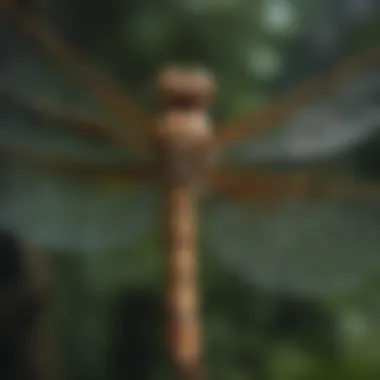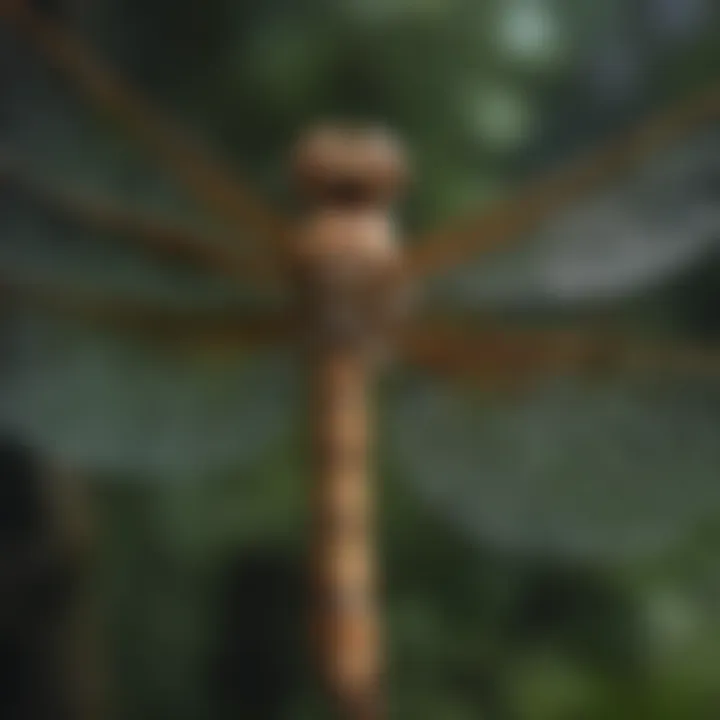Exploring the Fascinating Types of Flying Insects


Intro
The world of flying insects offers fascinating insights into ecological dynamics. These organisms participate actively in varied ecosystems, serving vital functions that affect biodiversity and environmental health. Their sheer diversity, adaptive features, and critical roles warrant a closer look at their interactions with both nature and human activities. Understanding the nuances of their anatomy, behavior, and ecological significances can lead to better management and conservation strategies. As we explore types of flying insects, we will highlight their relevance in ecosystems, the complexities of their interactions, and current trends in entomological research.
Understanding Woodland Ecosystems
Woodland ecosystems are complex and dynamic environments. They support a multitude of life forms, including various species of flying insects. These insects contribute significantly to the ecological balance within the forests.
Importance of Biodiversity in Forests
Biodiversity in forests is crucial for maintaining ecosystem stability. Flying insects, such as butterflies and bees, are essential pollinators for many plant species. Their role in reproduction stimulates plant growth, which in turn supports wildlife. Diverse insect populations also ensure that nutrient cycles and energy flows are intact. A robust diversity leads to a resilient ecosystem capable of withstanding changes and disturbances.
Role of Forests in Climate Regulation
Forests play a critical role in regulating the climate. They sequester carbon dioxide, a key greenhouse gas, contributing to the mitigation of climate change. Flying insects, during their life cycles, also interact with carbon cycling. For instance, the decomposition of organic matter by insects helps release nutrients back into the soil. Recognizing the interconnectedness between flying insects and forest health is imperative in the fight against climate change.
Sustainable Forestry Practices
Embracing sustainable forestry practices is essential for preserving woodland ecosystems. These practices aim to balance the ecological health of forest areas while providing resources for human use.
Principles of Sustainable Forestry
- Maintaining Forest Health: Regular assessments to avoid overharvesting and promote natural regeneration.
- Protecting Biodiversity: Ensuring the survival of various species, including flying insects, through habitat conservation.
- Community Engagement: Involving local communities in decision-making processes fosters stewardship and sustainable development.
Case Studies of Successful Implementations
- The Forest Stewardship Council: Promotes responsible forest management worldwide, enhancing biodiversity conservation.
- Community Forestry Initiatives in Nepal: Show how local involvement can lead to effective conservation practices and improved livelihoods.
Woodland Stewardship Techniques
Effective woodland stewardship is about proactive actions that enhance the integrity of forest ecosystems while addressing human needs.
Forest Management Plans
Forest management plans are essential for guiding decision-making. These documents outline strategies for sustainable resource use, conservation efforts, and biodiversity protection. Regular updates ensure that strategies remain relevant and effective in changing environments.
Conservation Strategies
Conservation strategies can include:
- Creating Protected Areas: Safeguarding critical habitats of flying insects and other wildlife.
- Restoration Projects: Reviving degraded areas to restore their ecological functions and biodiversity.
Understanding Flying Insects
Understanding flying insects is crucial for many fields, including ecology, agriculture, and environmental science. These organisms play significant roles in various ecosystems, affecting both plant and animal life through pollination, decomposition, and as part of the food web. By comprehending their biology and behavior, professionals can better manage their interactions with humans and the environment. This article will explore various types of flying insects, focusing on their taxonomy, evolutionary traits, and ecological importance, which will enrich both academic understanding and practical application in related fields.
Definition and Classification
Flying insects, part of the class Insecta, are characterized by their ability to fly, thanks to their two pairs of wings. They can be classified into several orders based on distinctive features such as wing structure and life cycle. Among these orders are Diptera, which includes flies; Hymenoptera, encompassing bees and wasps; Lepidoptera, containing butterflies and moths; and Coleoptera, commonly known as beetles. Each order exhibits unique anatomical, physiological, and ecological characteristics that provide insight into their diverse roles in the environment.
Evolution of Flight in Insects
The evolution of flight in insects is a complex process that has fascinated scientists. It is believed that flight evolved to enable more efficient foraging strategies and escape from predators. The development of wings from ancestral thoracic appendages marks a significant evolutionary milestone. Studies suggest that this adaptation has occurred independently in various insect lineages, demonstrating the evolutionary pressures that shape biodiversity. The emergence of flight has allowed insects to exploit a wider range of habitats and food sources, contributing to their success on Earth.
Anatomy of Flying Insects
The anatomy of flying insects is essential to understand how they achieve powered flight and navigate their environments. The key components involved in flight include the wing structure, muscular adaptations, and body size and weight considerations.
Wing Structure
The wing structure of flying insects is designed for both lift and maneuverability. Most flying insects possess two pairs of wings, which are often membranous and lightweight. This design reduces drag and allows for rapid adjustments during flight. One of the most notable features is the flexible nature of the wings. They can bend and twist to react to aerodynamic forces, enhancing their flight efficiency and agility. The adaptability of wing structure also influences how different species can inhabit various ecological niches.
Muscular Adaptations
Muscular adaptations in flying insects greatly enhance their ability to fly. The muscles involved in wing movement are highly developed, especially in species such as bees and moths, which require powerful and precise wing strokes. The key characteristic of these muscles is their ability to contract rapidly, generating thrust. Some insects also utilize synchronous or asynchronous muscle systems to optimize energy expenditure during flight. This adaptability allows for various flight patterns needed for feeding, mating, and escaping from predators.
Body Size and Weight Considerations
Body size and weight are critical factors affecting flight performance in insects. Smaller body sizes generally allow for lighter weights, which facilitate easier lift-off and maneuverability. However, larger insects may experience challenges due to the square-cube law, which affects their weight relative to the strength of their wing structures. Notably, the physical dimensions of the body can also correlate with flight speed and endurance. This relationship showcases how body size and weight are integral to the overall mechanics of flight in various insect species.


Major Orders of Flying Insects
The significance of the Major Orders of Flying Insects lies in their diversity and ecological roles. Each order presents unique characteristics, adaptations, and interactions with the environment. By studying these orders, we can deepen our understanding of insect biodiversity. Furthermore, these flying insects contribute to various ecosystems, influencing food webs, pollination, and decomposition processes. Their classification helps entomologists research and identify species in order to assess conservation needs and impacts of environmental changes.
Order Diptera (Flies)
Characteristics of Diptera
The Order Diptera, known commonly as flies, is characterized by their single pair of wings. This feature sets them apart from other insects that typically have two pairs. Flies possess halteres, which are modified hindwings that help maintain stability during flight. This adaptation enhances maneuverability, allowing them to navigate complex environments effectively. Their mouthparts vary, enabling feeding from various sources ranging from nectar to decaying matter.
Notable Species
Within the Order Diptera, some notable species include the common housefly (Musca domestica), the fruit fly (Drosophila melanogaster), and the horsefly (Tabanus species). Each species has unique traits that contribute to their ecological niches. For instance, the fruit fly is widely used in genetic studies due to its rapid lifecycle and simple genetic structure. This makes it a popular choice among scientists for experimental research, particularly in genetics and behavior studies.
Ecological Importance
The ecological importance of Diptera is vast. Flies play crucial roles in pollination, serving as food sources for many animals. They are also significant decomposers, aiding in the breakdown of organic material. This contributes to nutrient cycling within ecosystems. For example, many species of flies are attracted to decaying matter, where they facilitate decomposition processes essential for soil health. Their presence influences both plant and animal populations, highlighting their integral role in ecosystem functionality.
Order Hymenoptera (Bees, Wasps, Ants)
Structure and Function
Hymenoptera, which includes bees, wasps, and ants, exhibits a unique structure characterized by two pairs of wings and a narrow waist. This unique anatomy allows them to fly efficiently while also aiding in complex social behaviors. The mandibulate mouthparts in some species are specifically adapted for chewing or sucking, facilitating various feeding strategies. Their structural diversity enhances their functional capabilities in various ecological roles, making them a focus of study in both ecology and evolution.
Pollination and Ecosystem Service
One of the key contributions of Hymenoptera is their role in pollination. Many species, particularly bees, are vital for pollinating flowering plants. This symbiotic relationship supports biodiversity and agricultural productivity. The effectiveness of bees as pollinators significantly influences crop yields, making them essential in ecosystem services. Without their contributions, many plants would struggle to reproduce, leading to declines in plant diversity and health.
Social Behavior in Hymenoptera
The social structures in Hymenoptera are fascinating. Ants, bees, and wasps exhibit complex behaviors, including division of labor. For instance, worker bees forage for food and care for the queen's larvae, ensuring colony survival. This intricate social organization enhances their efficiency and adaptability. As they collaborate for mutual benefit, they create robust communities that strengthen ecosystem interactions, showcasing the importance of social behaviors in survival and reproductive success.
Order Lepidoptera (Butterflies and Moths)
Lifecycle Stages
The lifecycle stages of Lepidoptera, including butterflies and moths, are essential for their development and adaptation. They undergo a complete metamorphosis, transitioning from egg to larva (caterpillar), then to pupa (chrysalis), before finally emerging as adults. This process allows for various adaptations at different stages, with larvae often feeding on specific host plants, minimizing competition with adults. Such strategies enhance survival and reproductive success, reflecting the complexity of their ecological roles.
Adaptive Coloration
Adaptive coloration is a critical characteristic in Lepidoptera. Many butterflies and moths have evolved coloration patterns that provide camouflage or serve as signals to attract mates. For example, the vibrant colors of some butterflies can deter predators by signaling toxicity. This adaptation aids in survival while also playing a role in reproduction, where coloration influences mate selection. Thus, adaptive coloration highlights the interplay between evolution and ecological dynamics in these insects.
Role as Pollinators
In addition to their aesthetic value, Lepidoptera are important pollinators, particularly butterflies. Their unique mouthparts allow them to feed on nectar while transferring pollen between plants. This activity promotes plant reproduction and contributes to maintaining healthy ecosystems. However, the decline in many butterfly populations due to habitat loss raises concerns about their effectiveness as pollinators, emphasizing the need for conservation efforts.
Order Coleoptera (Beetles)
Key Features
Coleoptera, commonly known as beetles, are distinguished by their hardened forewings (elytra) that protect their hind wings and bodies. This feature not only provides defense but also aids in adaptation to various habitats. Beetles are the most diverse group in the insect world and possess varied feeding strategies, allowing them to occupy various niches in ecosystems. This diversity makes them essential study subjects for understanding ecology and evolution.
Resistance Adaptations
Many species in Coleoptera have developed resistance adaptations against environmental challenges, such as predators and harsh climates. This includes chemical defenses that deter predators and physical adaptations that enhance mobility or camouflage. Such traits enable them to thrive in diverse environments and contribute to ecological balance. Studying these resistance mechanisms adds depth to our understanding of evolutionary processes in insects.
Ecological Contributions
The ecological contributions of beetles are significant. They participate in processes such as decomposition and nutrient cycling, breaking down organic matter and returning nutrients to the soil. Additionally, some beetles are important prey for larger animals, linking various food webs. As indicators of ecological health, beetles are valuable in assessing environmental conditions. Their diversity and roles make them essential components of ecosystems, reinforcing the interconnectedness of life.
Adaptations for Flight
The adaptations of insects for flight are crucial for understanding their ecological roles and evolutionary success. Flight provides significant advantages, such as escaping predators, dispersing to new habitats, and accessing various food sources. Each adaptation intricately relates to the overall functioning of these organisms within their environments.
Morphological Adaptations
Wing Shape and Flexibility
Wing shape and flexibility are key factors in how insects achieve flight. Different species exhibit diverse wing forms that enhance their maneuverability and speed. For example, dragonflies have broad wings, providing stability in the air, enabling complex aerial maneuvers. Their unique wing structure allows for independent movement of each wing, contributing to agility while flying. This flexibility is particularly important for species that rely on precision and quick direction changes to catch prey or avoid threats.


A significant feature of wing shape is the varying designs observed across species. Some insects possess long, narrow wings, ideal for swift, sustained flight, as seen in butterflies. Others have shorter, broader wings suited for hovering. This diversity reflects adaptation to specific ecological niches, highlighting how different wing shapes can be advantageous under varying environmental pressures.
Body Streamlining
Body streamlining is another essential adaptation that complements flight capabilities. The streamlined body reduces air resistance, allowing faster movement and increasing flight efficiency. Insects like hawk moths exhibit elongated, sleek bodies that assist in rapid flight over extended distances. This characteristic significantly contributes to their foraging success in diverse habitats.
Additionally, a streamlined body often correlates with reduced weight, benefiting overall mobility. However, this adaptation does have drawbacks. Insects that are highly streamlined may be less robust against environmental challenges, such as sudden wind changes or heavy rains, which could impact their survival rates during critical times.
Physiological Adaptations
Metabolic Rates and Energy Use
Metabolic rates and energy use are crucial for sustaining flight. Insects require significant energy to support their wing movement, which necessitates adaptations in metabolism. High metabolic rates allow them to quickly convert energy stored in food into necessary fuel for flight. This is particularly evident in moths and bees, which display rapid wing beats during foraging.
The efficiency of energy use is also notable in flying insects. By employing specialized respiratory systems, such as tracheae, they optimize oxygen delivery during flight. However, this high energy demand can create vulnerabilities. If food sources are scarce, insects might struggle to maintain adequate energy levels, affecting their ability to survive and reproduce.
Nervous System Enhancements
Nervous system enhancements play a vital role in the flight capabilities of insects. A well-developed nervous system allows for rapid signaling and reflexes essential for navigating complex aerial environments. This is particularly relevant for species that exhibit intricate flight patterns to evade predators, such as moths, who can swiftly alter their flight trajectory.
Key characteristics of the nervous system include specialized structures like large optic lobes, which assist in processing visual information crucial during flight. These enhancements improve their overall flight efficiency, enabling the pursuit of food or mate from a distance. However, complex nervous systems often demand more energy, creating a balance between flight capabilities and energy management.
Behavioral Adaptations
Flight Patterns
Flight patterns represent a behavioral adaptation that significantly influences survival and reproduction. The ability of flying insects to develop distinct patterns helps navigate various environments and maximize their foraging effectiveness. For instance, pollinators such as honeybees display specific flight routes to efficiently access flowers, while others may engage in erratic flight to confuse predators.
The unique feature of these flight patterns is their variation among species. While some insects fly steadily towards targets, others exhibit rapid zigzag movements. This variability provides insights into adaptive strategies employed by different species to thrive within diverse habitats, improving their chances for survival.
Mating Rituals in Flight
Mating rituals in flight demonstrate a fascinating behavioral adaptation that insets the significance of aerial interactions. Certain insects, like fireflies, utilize light signals during flight to attract mates, playing a crucial role in reproductive success. These aerial displays often take place during specific times, ensuring optimal conditions for mating.
The key characteristic of mating rituals in this context is the reliance on synchronized behaviors. Some species engage in cooperative flight maneuvers, enhancing mate attraction. However, these rituals can also have risks, as increased visibility may attract predators, potentially affecting the survival of participants during mating.
Overall, adaptations for flight greatly enhance insects' ecological dynamics and evolutionary success, offering insights into their intricate relationships with environments.
Ecological Roles of Flying Insects
Flying insects hold significant ecological roles that are crucial to various biological systems. Understanding these roles sheds light on their contributions to ecosystem functionality. They serve not just as pollinators but also as decomposers and participants in food webs. Their activities influence plant health, nutrient cycling, and species interactions. This section examines the vital functions of flying insects, highlighting their unique ecological contributions.
Pollinators
The Pollination Process
The pollination process is essential for many plants, particularly flowering species. Insects, especially bees and butterflies, facilitate this process by transferring pollen from one flower's anther to another flower's stigma. This activity promotes fertilization, thus enabling seed and fruit production. A key characteristic of pollination is its reliance on the physical attributes of flying insects, such as their hairy bodies, which trap pollen grains effectively. This process holds a prominent benefit for food production and biodiversity. The unique feature of diverse pollination methods ensures that various plants can reproduce, leading to genetic variation and ecosystem resilience. However, the decrease in pollinator populations poses disadvantages that threaten ecosystem balance.
Impact on Plant Diversity
Flying insects have a profound impact on plant diversity. Their pollination services promote the survival and proliferation of numerous plant species. A key characteristic of this impact is that many flowering plants depend entirely on specific insect species for reproduction. This dependence highlights the intricate relationships between insects and the flora around them. A notable benefit is the increased genetic diversity within plant populations, which enhances adaptability. However, the reliance on flying insects also presents challenges; if insect populations decline, it can lead to reduced plant diversity, which subsequently affects herbivores and other dependent species.
Decomposers
Role in Nutrient Cycling
Decomposing insects play a vital role in nutrient cycling. For instance, certain flies, such as blowflies, are among the first to arrive at decomposing organic matter. They facilitate the breakdown of dead plants and animals, returning essential nutrients to the soil. A central characteristic of this role is efficiency; these insects speed up the decomposition process significantly. This rapid breakdown benefits the ecosystem by maintaining soil health. The unique feature of decomposition by insects allows for the recycling of nutrients in a way that is more effective than microbial decomposition alone. Nonetheless, there may be challenges in balance, as overpopulation in decay areas can lead to ecosystem stress.
Examples of Decomposing Flies
There are numerous examples of decomposing flies, including the common housefly and the flesh fly. These flies are attracted to decaying organic matter, playing a crucial role in decomposition. A defining characteristic of decomposing flies is their larvae, which consume a wide range of organic material, contributing to nutrient recycling. This makes them valuable for waste management in natural ecosystems. A notable advantage includes their contribution to nutrient cycling and soil fertility. The disadvantage lies in their attraction to human environments, potentially causing health concerns and pest problems.
Prey and Predators
Ecosystem Balance
Flying insects are integral to maintaining ecosystem balance. They serve as both prey and predators within food webs. For instance, many birds and larger insects rely on smaller flying insects as a food source, highlighting their role in supporting higher trophic levels. A key characteristic of this balance is interdependence; the survival of predator species often hinges on the availability of flying insects. This dynamic ensures that populations remain regulated, preventing overpopulation of any single species. However, disruptions, such as habitat loss or pesticide use, can destabilize this balance, threatening ecosystem health.
Food Web Interactions


Food web interactions involving flying insects illustrate their interconnectedness within ecosystems. These insects interact with various species, from plants to other animal groups, forming complex food webs. One key characteristic of these interactions is their diversity; flying insects can be found in many food web levels, from producers to primary consumers. This diversity supports ecosystem resilience against disturbances. A unique aspect is the role of flying insects in controlling pest populations, which can benefit agriculture. Yet, if flying insects decline, the cascading effects on food webs could destabilize entire systems.
Human Interactions with Flying Insects
Human interactions with flying insects significantly shape ecosystems and agricultural practices. The relationship is complex, consisting of both positive and negative influences. Understanding this dynamic is crucial for effective management and conservation efforts.
Insect Pests
Impact on Agriculture
The impact of insect pests on agriculture is profound. Many flying insects, such as locusts and certain species of beetles, can devastate crops. They feed on foliage and fruits, leading to reduced yield. This is a major concern for farmers worldwide. Damage from pests can cost millions of dollars each year, straining both local economies and food supply chains. Thus, dealing with these pests is vital to maintaining agricultural productivity.
The key characteristic of this interaction is the rapid reproduction rate of certain aerial pests. For example, a single female can lay hundreds of eggs that hatch within days.
A unique feature of this aspect is the unpredictability of pest outbreaks. Weather conditions, global trade, and climate change can cause pest populations to surge unexpectedly. This unpredictability poses significant challenges to effective agricultural planning and pest control strategies. While insect pests can disrupt agriculture, awareness and monitoring can lead to better management practices.
Management Strategies
Effective management strategies are essential in mitigating the damage caused by flying insect pests. Integrated Pest Management (IPM) is often cited as a best practice. This approach combines biological, physical, and chemical methods. The aim is to minimize pest populations without harming beneficial insects.
A key characteristic of management strategies is their focus on sustainable practices. For instance, introducing natural predators to control pest populations can be beneficial. This method reduces reliance on harmful pesticides, which can have detrimental effects on the environment.
One unique feature is the role of technological advances. Innovations in pest detection, like pheromone traps and drones, allow for targeted interventions. This minimizes the overall impact on the ecosystem. Although these methods have advantages, they also come with challenges, such as cost and accessibility for small farmers.
Beneficial Species
Natural Pest Control
Natural pest control is an important aspect of the relationship between humans and flying insects, focusing on utilizing beneficial species to manage pest populations. For example, certain wasps and ladybugs feed on aphids and other harmful insects. By encouraging the presence of these natural predators, farmers can reduce the need for chemical pesticides.
The key characteristic of natural pest control is its effectiveness in maintaining ecological balance. Beneficial insects contribute to pest management strategies without introducing harmful substances into the environment.
A unique feature of this approach is its emphasis on biodiversity. Planting diverse crops and habitats can attract beneficial insects. This can lead to increased pollination and improved overall harvest quality. Natural pest control is a long-term solution, but it requires careful planning and ecosystem understanding.
Conservation Efforts
Conservation efforts for flying insects focus on preserving habitats and mitigating threats. The alarming decline in insect populations has raised awareness of their ecological importance. Conservation strategies are becoming essential in maintaining healthy ecosystems.
A key characteristic of conservation efforts is community involvement. Educating the public on the benefits of diverse insect populations promotes habitat protection. Programs that encourage pollinator gardens or native plant use can significantly impact local ecosystems.
One unique feature of these efforts is the establishment of protected areas. These zones are set aside for the conservation of natural habitats. While these areas contribute to biodiversity, they may also face challenges such as funding and regulatory support. Collectively, conservation of flying insects is crucial for sustaining biodiversity and promoting a healthy environment.
"The role of flying insects extends beyond mere nuisance; they are vital players in the balance of our ecosystems and agriculture."
In summary, human interactions with flying insects encompass both challenges and opportunities. By addressing pest issues and fostering beneficial relationships, we can enhance our ecological balance and agricultural practices.
Conservation of Flying Insects
Conservation of flying insects plays a crucial role in maintaining ecological balance and sustaining biodiversity. As these insects are integral to various ecological functions, their decline can lead to severe consequences. Their contributions range from pollination to serving as food for other wildlife. Without proper conservation efforts, we risk losing key species, thereby destabilizing food webs and disrupting ecosystems. Hence, addressing the threats to flying insects is vital for ensuring the health of our environment.
Threats to Flying Insects
Pesticides and Pollution
One of the most pressing threats to flying insects is the use of pesticides. Pesticides are chemicals designed to kill or manage pests; however, they often have unintended consequences on non-target insect populations. This aspect of pesticides illustrates a direct impact, reducing the number of pollinators, which can affect plant reproduction and overall plant health. Pesticides are popular in agriculture for their effectiveness, but their consequences on ecosystems can be detrimental.
The unique feature of pesticides lies in their broad-spectrum action, meaning they can kill various insect species indiscriminately. While they may protect crops in the short term, overreliance on pesticides can lead to resistant pest populations, prompting increased application and further harm to beneficial species. This creates a cycle that undermines the very purpose for which they were introduced.
Habitat Loss
Habitat loss is another significant threat to flying insects. As urban development expands and natural landscapes are altered for agriculture, the habitats these insects rely on are diminished. Urbanization and deforestation contribute significantly to habitat loss, resulting in decreased availability of resources necessary for survival.
The key characteristic of habitat loss is its permanence. Once a habitat is destroyed, it is often challenging for these insects to recover or adapt. This loss can isolate populations, limiting genetic diversity and reducing resilience to environmental changes. In this article, understanding the implications of habitat loss emphasizes the need for proactive measures to protect existing ecosystems and restore altered landscapes.
Conservation Strategies
Community Involvement
Community involvement is essential in the conservation of flying insects. Local initiatives can drive awareness and action, leading to increased efforts in protecting habitats. Engaging community members fosters a greater understanding of the importance of insects, encouraging activities such as creating pollinator gardens or participating in citizen science projects. This active participation can amplify conservation efforts and foster a connection between individuals and their environment.
A unique feature of community involvement is its ability to leverage local knowledge and resources. Communities that understand their ecosystems can tailor conservation efforts to their specific needs. Friendly competition, such as planting native flora, encourages community members to enhance local biodiversity while promoting sustainable practices.
Protected Areas and Legislation
Protected areas and legislation are vital components in the conservation framework for flying insects. These areas are designated to safeguard habitats and provide necessary protections from human activities. Establishing protected areas can help conserve biodiversity by ensuring that habitats remain intact and undisturbed.
The main characteristic of protected areas is their legal protection against development and exploitation. This ensures that ecosystems can persistently support flying insects. Legislation can empower governments and organizations to implement conservation strategies effectively. However, the enforcement of these laws can sometimes be challenging, requiring ongoing support to ensure real protection for at-risk insect populations.







